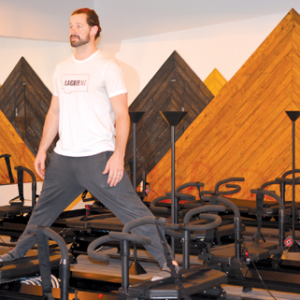By Evelyn Pyburn
It’s one of those cases where a Montanan wanted to come back home.
Dan Burgess and his wife, Tina, are opening in Billings the second location of a business they started in order to make their home in Montana. Featuring a unique physical fitness program they have opened Lagree MT Fitness Studio in Shiloh Commons, right next door to Sophie’s. They opened their first location in Missoula just over a year ago, which has been successful beyond their greatest expectations.
A graduate of Senior High School and the University of Montana, Burgess has had opportunities to explore many other parts of the country. He and Tina decided to make their home in Denver, where they became the parents of two children, and where both were engaged in lucrative jobs.
Tina, from Texas, had ample opportunity to become acquainted with Montana as they returned frequently to visit Dan’s parents and friends.
On one of those trips, they left the kids with Grandma and Grandpa and headed to one of their favorite get-a-ways, Chico Hot Springs. On the drive, Tina asked, “Why don’t we live here?” They had come to realize that while their jobs paid well, both “hated” their jobs, and Dan especially hated his daily two-hour commute to work. Their children were getting older and Dan wanted to be more involved with them. As a former football and basketball player, he wanted to be a volunteer coach for his kids and to be able to have time to take his family on outings in the summer – like going on a river float.
“We would have to start our own business,” was Dan’s reply to Tina’s question, because there just wasn’t the opportunity in Montana for the kind of jobs they had. The problem with starting their own business was a lack of “seed capital,” he said.
But, they did have seed capital, pointed out Tina – they had their house in Denver which had escalated in value beyond their wildest imagination. Hmmm, that’s something Dan figured he should have been first to think of, with a degree in financing and a masters from Simon Business School of the University of Rochester. But then, Tina, has her own business marketing degree from the University of San Diego.
Taking their resources into account, the couple started researching what kinds of business that would be successful in Montana. The potential they found in becoming licensed to operate Lagree Fitness studios fit the bill. Lagree is a workout program that brings a new level to health and fitness workouts and to physical training. While its founder, Sebastian Lagree, based the program on pilates it has evolved far beyond pilates, into a distinctively unique fitness technique that automatically customizes to the abilities and needs of each person, young or old, men and women, alike. The company has licensed upward of 500 business locations around the world.
Utilizing a piece of equipment called the Megaformer, highly trained coaches oversee regularly scheduled classes of “High Intensity Low Impact Full Body Muscular Endurance Training.”
The key to the workouts is a focus on perfect form, slow movements and no momentum, emphasized Dan, who oversees the staffing, training and financial end of the business. Each 45 minute workout utilizing “spring based tension,” exercises the whole body and builds, as an individual’s own strength builds. While training is conducted in groups, it’s still personalized, which is what their stringent training of coaches emphasizes, unlike most other group training, said Dan.
The exercises build cardio, muscular, core, flexibility and strength, and it takes about three sessions before an individual starts to “get it” and to feel the improvements. Because of that, Dan is currently offering anyone who wants to try, to participate in the first three sessions at no charge. All they need to do is go to the Lagree MT website, add the “BLGS – Intro 3 Pack” to their cart and type in the Promo Code “SHILOH3”.
The exercises have no high impact on joints and is easily adaptable to a person’s limitations or strengths. It can be used for regaining strength after a surgery or training for “pro-day.” It can be used by people like his mother, said Dan, just as much as high tier athletes. “The workout gets harder as you get stronger.”
Dan guarantees that no matter what regime an athlete is undertaking, Lagree will advance it in ways that always surprises. In fact, he says, with a knowing smile, guys who think they are in great shape, often make the mistake of thinking that if women can do it, it will be easy for them.
Classes are typically held before and after work hours, and during the noon hour. They quickly filled classes in Missoula relying mostly upon word-of- mouth. Their business remained viable despite the COVID regulations that forced them to close for 80 days, and which has discouraged some people from returning to regular exercising routines. Classes are beginning to fill up in Billings, too.
The COVID crisis did pause Dan and Tina in their expansion efforts. They had planned to open their second location during the summer. Eventually, they expect to have several locations in Montana with Missoula and Billings being their “bookends”.
Dan said they were excited being able to open in Shiloh Commons. Tina, it turns out, is very creative with a hammer, saw and paint brush. She has designed and furnished Lagree MT with a sharp, clean Industrial Modern theme, punctuated with several pieces of furniture that she also built, often using recycled materials.
In addition to those talents, she also oversees marketing for the company and oversees their online presence and social media.
Lagree MT employs five people in Missoula on a contract basis and have added three more in Billings, with the likelihood of adding another two or three in the near future.


